Balkinization
an unanticipated consequence of
Jack M. Balkin
Balkinization Symposiums: A Continuing List
E-mail:
Jack Balkin:
jackbalkin at yahoo.com
Bruce Ackerman
bruce.ackerman at yale.edu
Ian Ayres
ian.ayres at yale.edu
Corey Brettschneider
corey_brettschneider at brown.edu
Mary Dudziak
mary.l.dudziak at emory.edu
Joey Fishkin
joey.fishkin at gmail.com
Heather Gerken heather.gerken at yale.edu
Abbe Gluck abbe.gluck at yale.edu
Mark Graber
mgraber at law.umaryland.edu
Stephen Griffin
sgriffin at tulane.edu
Jonathan Hafetz
jonathan.hafetz at shu.edu
Jeremy Kessler
jkessler at law.columbia.edu
Andrew Koppelman
akoppelman at law.northwestern.edu
Marty Lederman
msl46 at law.georgetown.edu
Sanford Levinson
slevinson at law.utexas.edu
David Luban
david.luban at gmail.com
Gerard Magliocca
gmaglioc at iupui.edu
Jason Mazzone
mazzonej at illinois.edu
Linda McClain
lmcclain at bu.edu
John Mikhail
mikhail at law.georgetown.edu
Frank Pasquale
pasquale.frank at gmail.com
Nate Persily
npersily at gmail.com
Michael Stokes Paulsen
michaelstokespaulsen at gmail.com
Deborah Pearlstein
dpearlst at yu.edu
Rick Pildes
rick.pildes at nyu.edu
David Pozen
dpozen at law.columbia.edu
Richard Primus
raprimus at umich.edu
K. Sabeel Rahmansabeel.rahman at brooklaw.edu
Alice Ristroph
alice.ristroph at shu.edu
Neil Siegel
siegel at law.duke.edu
David Super
david.super at law.georgetown.edu
Brian Tamanaha
btamanaha at wulaw.wustl.edu
Nelson Tebbe
nelson.tebbe at brooklaw.edu
Mark Tushnet
mtushnet at law.harvard.edu
Adam Winkler
winkler at ucla.edu
Compendium of posts on Hobby Lobby and related cases
The Anti-Torture Memos: Balkinization Posts on Torture, Interrogation, Detention, War Powers, and OLC
The Anti-Torture Memos (arranged by topic)
Recent Posts
The Trump Administration’s War on Free Speech, the McCarthy Analogy, and the Limits of the First Amendment-- Part One
Just A Few Blogs
ACS Blog
Alas, a Blog
Althouse
Arts and Letters Daily
Atrios (Eschaton)
Bill of Health
Buzzflash.com
Buzz Machine
Cato at Liberty
Juan Cole (Informed Comment)
Concurring Opinions
The Constitution in 2020
Corrente
Crooked Timber
Daily Howler
Daily Kos
Dana Boyd
Brad DeLong
Digby (Hullabaloo)
Discriminations
Daniel Drezner
Kevin Drum (Mother Jones)
Electrolite
En Banc
Eunomia (Daniel Larison)
Fafblog
Michael Froomkin (Discourse.net)
GovLab (Beth Noveck)
Rick Hasen (Election Law)
History News Network
How Appealing
Ignatz (Sam Heldman)
The Importance of (Ernie Miller)
Infolaw
Instapundit
International Economic Law and Policy Blog
IntLawGrrls
Jacob Levy
Jesus' General
Jurisdynamics
The Kitchen Cabinet
Mark Kleiman
Law Blog Central
Larry Lessig
Lawyers, Guns and Money
Liberal Oasis
Brian Leiter's Law School Reports
The Leiter Reports
Marginal Revolution
Megan McArdle
Memeorandum
Metafilter
Mirror of Justice
The New Republic
Newseum
No More Mister Nice Blog
Brendan Nyhan
Opinio Juris
Orcinus
The Originalism Blog
Pandagon
Passport (Foreign Policy)
Overcoming Bias
Political Animal (Washington Monthly)
Political Theory Daily Review
Political Wire (Taegan Goddard)
The Poor Man
Virginia Postrel
Prawfsblawg
Public Reason
Jonathan Rauch
Raw Story
Redstate
ReligiousLeftLaw.com
Reporters Committee For Freedom of the Press
Reproductive Rights Blog
Rothman's Roadmap to the Right of Publicity
SCOTUS Blog
Seeing the Forest
Clay Shirky
The Shifted Librarian
The Situationist
Larry Solum (Legal Theory)
Andrew Sullivan
Talking Points Memo
Talk Left
Tapped
Tbogg
TechPresident
The Paper Chase (Jurist)
Tom Paine
Tom Tomorrow (This Modern World)
Eve Tushnet
Uggabugga
University of Chicago Law School Faculty Blog
Unqualified Offerings
The Volokh Conspiracy
War and Piece (Laura Rozen)
Wampum
Oliver Willis
Wonkette
Written Description
Matthew Yglesias
Yin
Your Choice of Feeds
1. XML
powered by
2. Atom Feed
3. RSS 2.0
The Trump Administration’s War on Free Speech, the McCarthy Analogy, and the Limits of the First Amendment-- Part One
Guest Blogger
For the Balkinization symposium on Free Speech in Crisis and the Limits of the First Amendment. Genevieve Lakier
[This is Part One of a two part essay.] The
United States is currently facing the most serious attack on freedom of speech
that anyone reading this has likely experienced in their lifetime. Over the
past hundred or so days, the Trump administration has attempted to undermine
the independence of not merely some of the institutions that traditionally fuel
and shape the democratic public sphere in the United States, but virtually all
of them. The administration has used the levers of federal power to punish, or
threaten to punish, members of the news media, universities, law firms, libraries, not to mention many of the federal scientific and data-gathering bureaucracies. Even major public
cultural institutions like the Kennedy Center and the Smithsonian have been targeted as part of
this campaign of what can only be described as a project of ideological
purification. In
the face of this concerted attack on the independence of the democratic public
sphere and, by proxy, the very foundations of American democracy itself, it is
natural to seek analogies from other times and places to help make the scary
novelty of this moment somewhat less so. Two sets of comparisons are clearly
relevant. The first is to similar campaigns of ideological purification that
have occurred recently in other countries—for example, India, or Mexico, or Hungary.
The second is to campaigns of political repression that occurred in the United
States in previous decades—the most obvious parallel being the campaign of
political repression that occurred during the Second Red Scare, or the McCarthy
Era. Both
analogies are helpful for understanding what the current wave of repression
might be designed to accomplish, as well as what is and is not unique about it.
For First Amendment scholars, however, the analogy to the McCarthy Era is
particularly revealing. This is because, although the political character of the
Trump administration’s speech repression differs in important ways from that
which characterized the Second Red Scare—in particular, it is focused far more
on political opposition, not just radical groups and speakers, and is therefore
less bipartisan and more authoritarian in character (more akin in that respect
to the repression in contemporary Hungary than 1950s America)—its methods are
remarkably similar to those that government actors employed during the McCarthy
Era. Just
as was true during the Second Red Scare, the Trump administration has not been relying
upon the censorship tools most familiar to courts—namely, the direct, usually
criminal, prohibition of speech that was the favored tool of repression during
the First Red Scare and that modern First Amendment law consequently developed
in large part against. Instead, like
government officials during the McCarthy Era, the administration has been
relying upon other ways of chilling speech: pledges to refrain from certain
kinds of speech or association in order to maintain employment or receive
government benefits (what during the McCarthy period were generally called “loyalty
oaths”); intrusive information requests targeted at unpopular speakers or
groups, mass firings of potentially disloyal workers, and speech-related deportations
that seek to chill disfavored speech. These
were, of course, not the only tools of speech repression that officials used
during the Second Red Scare. Officials
also used the criminal laws to punish Communist speech and association, as the
Supreme Court’s infamous decision in Dennis v. United States illustrates. But doing so was
controversial and costly, in part due to the echoes it raised of the past. Hence,
government actors primarily relied upon other, more indirect, but nevertheless
often extremely effective mechanisms to exclude radical speakers from the
public sphere. The
fact that the Trump administration is relying upon many of the same tactics of
speech repression that state and federal officials relied upon during the
Second Red Scare is no coincidence. It reflects how officials respond to the
constraints imposed by courts by exploiting areas of doctrinal ambiguity and judicial
deference. The
similarities in the tactics used then and now also raise important questions
for First Amendment scholars, however. This is because many of the most
distinctive features of contemporary First Amendment law—its formalism, its
hatred of balancing, its commitment to the protection of extreme and hateful
viewpoints—can be understood as a reaction to the problems of the McCarthy Era,
and more specifically, to the failure of courts to adequately protect the free
speech interests of those targeted by the anti-Communist campaigns. The
repetition of similar tactics today, and their vigorous contestation in courts
throughout the country, thus provides an important opportunity to analyze
whether and to what extent First Amendment doctrine has improved from what it
was seventy years ago. How well does the contemporary doctrine safeguard free
speech values against what we might describe as the Second Generation
censorship tools employed during the McCarthy Era and by Trump officials today?
And what changes need to be made to make First Amendment law more effective
against these tools in the future? These
are the central questions that the current moment poses for First Amendment
scholars. They are questions that it is obviously much too early to be able to
answer definitively. The owl of Minerva is very far from taking flight, and the
many First Amendment cases that the administration’s actions have spawned have
only just started wending their way through the courts. But there are some
important lessons we can learn, even at this early moment. 1. The Rule Against Content Discrimination Will Not Save Us A
primary focus of the post-McCarthy Court’s First Amendment jurisprudence has
been the effort to limit the government’s capacity to sanction speech, either
civilly or criminally, because of its expressive content. Most famously, in Brandenburg
v. Ohio, the
Court rejected the loosey-goosey balancing test it employed in Dennis
and interpreted the First Amendment to impose very significant limits on the
government’s ability to punish revolutionary speech, or other speech that
conveyed a message that officials feared would incite lawbreaking. But Brandenburg
was not unique. In many other cases, the Court interpreted the First Amendment to make it
generally very difficult for the government to civilly or criminally punish speech because of its
expressive content. By
reading a strong rule against this kind of content discrimination into the
First Amendment, the Court was clearly intending to correct for the mistakes of
the past by more vigorously protecting the right of speakers to engage in subversive
or merely oppositional speech. And it achieved this aim, to some degree. The
Trump administration would clearly love nothing better than to throw its
critics into jail, or to win steep defamation judgments against them. (Indeed,
Trump keeps threatening to do both). But the administration cannot
easily make good on these threats, given the post-McCarthy Era precedents. This
is obviously a very good thing. There are, after all, few more effective ways
of silencing your critics than putting them in jail or bankrupting them. The result is that the current wave of
repression is less repressive than it would have been in a world absent a
strong First Amendment rule against content discrimination. It is still plenty
repressive, however, as the past few months have clearly demonstrated. This
means that more attention needs to be paid—and indeed, is all of a sudden being
paid—to the other ways in which the First Amendment limits the
government’s ability to control public expression than by restricting its power
to criminally or civilly sanction speech because of its content. And when we
turn to these other reaches of First Amendment law, what we find is that the
strength of the doctrinal protections, and the improvements that the courts
have made to the doctrine, since the 1950s, varies considerably. 2. The Jawboning Case Law is Turning Out to Be Really Important One
area in which First Amendment doctrine is much more able today to defend
private expressive autonomy against campaigns of ideological purification and
speech control than was true seventy years ago is in the protection it provides
against efforts by government officials to pressure private companies or
persons into doing their dirty work for them by threatening them with negative
consequences if they do not suppress either their own speech or that of others,
or disassociate themselves from disfavored groups. These
governmental efforts—which are often referred to in academic and popular discourse
as “jawboning”—represent one of the most
important mechanisms of the Trump administration’s speech repression. Indeed, many of the administration’s attacks on
law firms, universities, foreign students, and contractors can and should be
conceptualized as acts of jawboning, insofar as they function to chill speech
by threatening speakers and speech platforms with serious financial or legal
consequences if they do not either shut up or begin speaking in ways that the
administration approves. Jawboning
was also an important tactic of political repression during the McCarthy Era. Indeed,
a primary goal of the House Committee on Un-American Activities was, as Judge Edgerton
of the D.C. Circuit put it in a 1948 opinion, “to do by exposure and
publicity what it believes may not validly be done by legislation.” These efforts to publicly tar leftists with
the brush of being a subversive and thereby pressure others into disassociating
from them, in order to avoid being similarly tarred, were often extremely
successful—as Ellen Schrecker and others have documented. Yet
the courts had a hard time conceptualizing these efforts as acts of speech suppression
within the terms of the existing free speech order, given the sharp divide that
the cases then drew between state and private action. Courts tended to view the
failure of those publicly identified as subversives by government actors to “attract audiences, enlist
members, or obtain contributions as readily as before” they were targeted as “sanctions
applied by public disapproval, not by law”—as Justice Jackson put it, in a 1951
concurrence, and therefore as
something that, notwithstanding whatever chill it might impose on protected
expression, was simply not something that raised First Amendment concerns. When courts construed these acts
of public stigmatization as unconstitutional, it was because they were
understood to violate Fifth Amendment due process, not First Amendment speech
rights. Contemporary
judges have a much easier time recognizing these kinds of jawboning campaigns
as a First Amendment problem. That they are able to do so is a function in part
of the Warren Court’s efforts to develop a more anti-formalist First Amendment
jurisprudence, one that focused far more than prior doctrine on the chilling
effects of state actions rather than just their formal character. These efforts
produced the foundational decisions in this line of cases, including Smith v California and Bantam Books v. Sullivan. But
the strength of the First Amendment protections against jawboning is also a product
of much more recent developments—chief among these, the intense fight about the
regulation of speech on social media that occurred after companies like
Facebook and Twitter began kicking speakers, including President Trump, off
their platforms for violating their rules. Litigants went to court to argue
that the deplatforming of (in many cases, conservative) speakers was in fact a
consequence of state, not purely private, action—and more specifically, that it
was a response to the pressure tactics of Democratic politicians. The flood of cases in which these kinds of arguments
were made, and the sympathy that some of the justices clearly felt towards them,
ultimately led the Court to agree to hear two jawboning cases in one term,
after sixty years of not hearing any. The
result was the unanimous decision in NRA
v. Vullo which reaffirmed, and in some
respects expanded on the anti-jawboning rule the
Court first announced in Bantam Books. It is this case, more perhaps than any others,
that today shores up the legal resistance to the Trump administration’s intimidation
campaigns. Indeed, the complaint Harvard filed to challenge the
Trump administration’s funding cuts relied heavily on Vullo; so too did
the opinion issued last week that permanently enjoined the Executive Order that President
Trump issued against the law firm Perkins Coie; and so too did the district court opinion that, just a few weeks ago,
allowed an ambitious First Amendment challenge to the administration’s
speech-focused deportation policy to proceed. There
is a certain irony to the fact that it was Republican concern with Biden
administration efforts to jawbone the social media companies that helped lead
to the reaffirmation of a rule that now is being used, so far quite
successfully, to defend against efforts by the Trump administration to jawbone
everyone but the social media companies. Nevertheless, the fact that the
decision that is currently playing such an important role in challenging
Trumpist speech suppression is not only so recent but a product of the culture
wars that help motivate that repression also suggests how contingent the
strength of this doctrinal safeguard may be, and how much remains to be done to
shore it up. Indeed, until Vullo, the lower courts had proven quite inconsistent in their approach to First
Amendment jawboning challenges. If
courts fail to heed the clear signal of the unanimous Court in Vullo
that the anti-jawboning rule should be interpreted broadly, there is still a possibility
that the First Amendment will provide only incomplete protection against
the Trump administration’s jawboning. But
interpreted on their own terms, Bantam Books and Vullo recognize
how speech repression operates in practice and provide the doctrinal tools to guard
against the often subtle and informal forms that such repression can take. This
is a very good thing, because if there is any style of governing that best
characterizes that of President Trump (like Senator Joe McCarthy before him) it
is the mode of the bully—precisely the kind of government action that the
jawboning precedents protect against. Genevieve Lakier is Professor of Law, Herbert and Marjorie Fried Teaching Scholar, University of Chicago Law School. You can reach her by e-mail at glakier@uchicago.edu.
Posted
9:30 AM
by Guest Blogger [link]
Books by Balkinization Bloggers

Linda C. McClain and Aziza Ahmed, The Routledge Companion to Gender and COVID-19 (Routledge, 2024)

David Pozen, The Constitution of the War on Drugs (Oxford University Press, 2024)

Jack M. Balkin, Memory and Authority: The Uses of History in Constitutional Interpretation (Yale University Press, 2024)
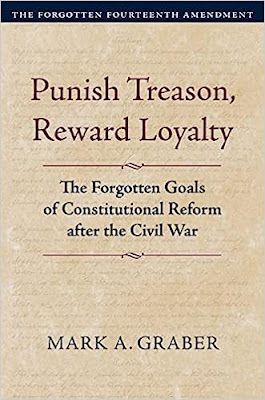
Mark A. Graber, Punish Treason, Reward Loyalty: The Forgotten Goals of Constitutional Reform after the Civil War (University of Kansas Press, 2023)
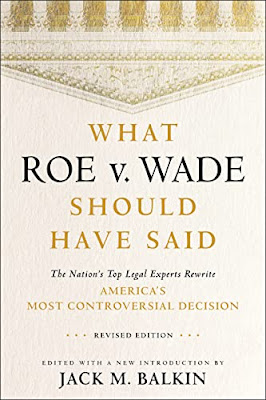
Jack M. Balkin, What Roe v. Wade Should Have Said: The Nation's Top Legal Experts Rewrite America's Most Controversial Decision - Revised Edition (NYU Press, 2023)

Andrew Koppelman, Burning Down the House: How Libertarian Philosophy Was Corrupted by Delusion and Greed (St. Martin’s Press, 2022)

Gerard N. Magliocca, Washington's Heir: The Life of Justice Bushrod Washington (Oxford University Press, 2022)
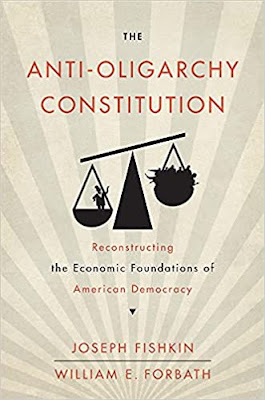
Joseph Fishkin and William E. Forbath, The Anti-Oligarchy Constitution: Reconstructing the Economic Foundations of American Democracy (Harvard University Press, 2022)
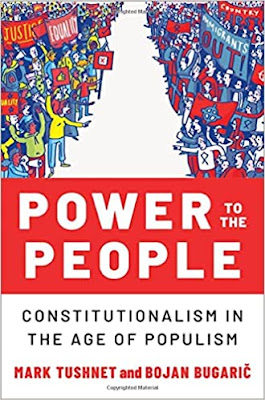
Mark Tushnet and Bojan Bugaric, Power to the People: Constitutionalism in the Age of Populism (Oxford University Press 2021).

Mark Philip Bradley and Mary L. Dudziak, eds., Making the Forever War: Marilyn B. Young on the Culture and Politics of American Militarism Culture and Politics in the Cold War and Beyond (University of Massachusetts Press, 2021).

Jack M. Balkin, What Obergefell v. Hodges Should Have Said: The Nation's Top Legal Experts Rewrite America's Same-Sex Marriage Decision (Yale University Press, 2020)

Frank Pasquale, New Laws of Robotics: Defending Human Expertise in the Age of AI (Belknap Press, 2020)

Jack M. Balkin, The Cycles of Constitutional Time (Oxford University Press, 2020)

Mark Tushnet, Taking Back the Constitution: Activist Judges and the Next Age of American Law (Yale University Press 2020).

Andrew Koppelman, Gay Rights vs. Religious Liberty?: The Unnecessary Conflict (Oxford University Press, 2020)

Ezekiel J Emanuel and Abbe R. Gluck, The Trillion Dollar Revolution: How the Affordable Care Act Transformed Politics, Law, and Health Care in America (PublicAffairs, 2020)

Linda C. McClain, Who's the Bigot?: Learning from Conflicts over Marriage and Civil Rights Law (Oxford University Press, 2020)
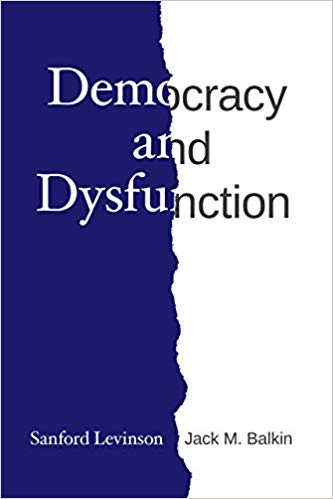
Sanford Levinson and Jack M. Balkin, Democracy and Dysfunction (University of Chicago Press, 2019)

Sanford Levinson, Written in Stone: Public Monuments in Changing Societies (Duke University Press 2018)

Mark A. Graber, Sanford Levinson, and Mark Tushnet, eds., Constitutional Democracy in Crisis? (Oxford University Press 2018)

Gerard Magliocca, The Heart of the Constitution: How the Bill of Rights became the Bill of Rights (Oxford University Press, 2018)

Cynthia Levinson and Sanford Levinson, Fault Lines in the Constitution: The Framers, Their Fights, and the Flaws that Affect Us Today (Peachtree Publishers, 2017)

Brian Z. Tamanaha, A Realistic Theory of Law (Cambridge University Press 2017)

Sanford Levinson, Nullification and Secession in Modern Constitutional Thought (University Press of Kansas 2016)

Sanford Levinson, An Argument Open to All: Reading The Federalist in the 21st Century (Yale University Press 2015)

Stephen M. Griffin, Broken Trust: Dysfunctional Government and Constitutional Reform (University Press of Kansas, 2015)

Frank Pasquale, The Black Box Society: The Secret Algorithms That Control Money and Information (Harvard University Press, 2015)

Bruce Ackerman, We the People, Volume 3: The Civil Rights Revolution (Harvard University Press, 2014)
Balkinization Symposium on We the People, Volume 3: The Civil Rights Revolution

Joseph Fishkin, Bottlenecks: A New Theory of Equal Opportunity (Oxford University Press, 2014)

Mark A. Graber, A New Introduction to American Constitutionalism (Oxford University Press, 2013)

John Mikhail, Elements of Moral Cognition: Rawls' Linguistic Analogy and the Cognitive Science of Moral and Legal Judgment (Cambridge University Press, 2013)

Gerard N. Magliocca, American Founding Son: John Bingham and the Invention of the Fourteenth Amendment (New York University Press, 2013)

Stephen M. Griffin, Long Wars and the Constitution (Harvard University Press, 2013)

Andrew Koppelman, The Tough Luck Constitution and the Assault on Health Care Reform (Oxford University Press, 2013)

James E. Fleming and Linda C. McClain, Ordered Liberty: Rights, Responsibilities, and Virtues (Harvard University Press, 2013)
Balkinization Symposium on Ordered Liberty: Rights, Responsibilities, and Virtues

Andrew Koppelman, Defending American Religious Neutrality (Harvard University Press, 2013)

Brian Z. Tamanaha, Failing Law Schools (University of Chicago Press, 2012)

Sanford Levinson, Framed: America's 51 Constitutions and the Crisis of Governance (Oxford University Press, 2012)

Linda C. McClain and Joanna L. Grossman, Gender Equality: Dimensions of Women's Equal Citizenship (Cambridge University Press, 2012)

Mary Dudziak, War Time: An Idea, Its History, Its Consequences (Oxford University Press, 2012)

Jack M. Balkin, Living Originalism (Harvard University Press, 2011)

Jason Mazzone, Copyfraud and Other Abuses of Intellectual Property Law (Stanford University Press, 2011)

Richard W. Garnett and Andrew Koppelman, First Amendment Stories, (Foundation Press 2011)

Jack M. Balkin, Constitutional Redemption: Political Faith in an Unjust World (Harvard University Press, 2011)

Gerard Magliocca, The Tragedy of William Jennings Bryan: Constitutional Law and the Politics of Backlash (Yale University Press, 2011)

Bernard Harcourt, The Illusion of Free Markets: Punishment and the Myth of Natural Order (Harvard University Press, 2010)

Bruce Ackerman, The Decline and Fall of the American Republic (Harvard University Press, 2010)
Balkinization Symposium on The Decline and Fall of the American Republic

Ian Ayres. Carrots and Sticks: Unlock the Power of Incentives to Get Things Done (Bantam Books, 2010)

Mark Tushnet, Why the Constitution Matters (Yale University Press 2010)
Ian Ayres and Barry Nalebuff: Lifecycle Investing: A New, Safe, and Audacious Way to Improve the Performance of Your Retirement Portfolio (Basic Books, 2010)
.jpg)
Jack M. Balkin, The Laws of Change: I Ching and the Philosophy of Life (2d Edition, Sybil Creek Press 2009)

Brian Z. Tamanaha, Beyond the Formalist-Realist Divide: The Role of Politics in Judging (Princeton University Press 2009)
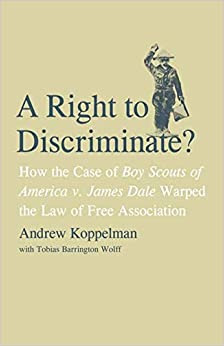
Andrew Koppelman and Tobias Barrington Wolff, A Right to Discriminate?: How the Case of Boy Scouts of America v. James Dale Warped the Law of Free Association (Yale University Press 2009)

Jack M. Balkin and Reva B. Siegel, The Constitution in 2020 (Oxford University Press 2009)
Heather K. Gerken, The Democracy Index: Why Our Election System Is Failing and How to Fix It (Princeton University Press 2009)

Mary Dudziak, Exporting American Dreams: Thurgood Marshall's African Journey (Oxford University Press 2008)

David Luban, Legal Ethics and Human Dignity (Cambridge Univ. Press 2007)

Ian Ayres, Super Crunchers: Why Thinking-By-Numbers is the New Way to be Smart (Bantam 2007)

Jack M. Balkin, James Grimmelmann, Eddan Katz, Nimrod Kozlovski, Shlomit Wagman and Tal Zarsky, eds., Cybercrime: Digital Cops in a Networked Environment (N.Y.U. Press 2007)
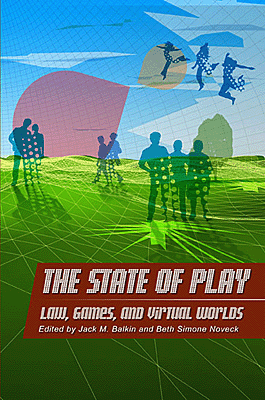
Jack M. Balkin and Beth Simone Noveck, The State of Play: Law, Games, and Virtual Worlds (N.Y.U. Press 2006)

Andrew Koppelman, Same Sex, Different States: When Same-Sex Marriages Cross State Lines (Yale University Press 2006)
Brian Tamanaha, Law as a Means to an End (Cambridge University Press 2006)
Sanford Levinson, Our Undemocratic Constitution (Oxford University Press 2006)
Mark Graber, Dred Scott and the Problem of Constitutional Evil (Cambridge University Press 2006)
Jack M. Balkin, ed., What Roe v. Wade Should Have Said (N.Y.U. Press 2005)
Sanford Levinson, ed., Torture: A Collection (Oxford University Press 2004)
Balkin.com homepage
Bibliography
Conlaw.net
Cultural Software
Writings
Opeds
The Information Society Project
BrownvBoard.com
Useful Links
Syllabi and Exams